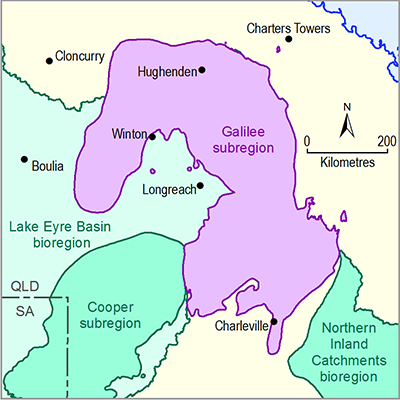- Home
- Assessments
- Bioregional Assessment Program
- Galilee subregion
- 2.7 Receptor impact modelling for the Galilee subregion
- 2.7.2 Overview
- 2.7.2.6 'Non-floodplain, terrestrial GDE' landscape group
The ‘Non-floodplain, terrestrial GDE’ landscape group consists of two landscape classes. Of these two classes, most of the landscape group within the zone of potential hydrological change is classed as remnant vegetation. Specifically, ‘Non-floodplain, terrestrial GDE, remnant vegetation’ occupies an area of about 1184 km2 within the zone, whereas ‘Non-floodplain, terrestrial GDE’ occupies about 5.5 km2.
Two relatively simple signed digraph models were developed during the qualitative modelling workshop for the vegetative community associated with the ‘Non-floodplain, terrestrial GDE’ landscape group. The models focused on recruitment dynamics associated with groundwater-dependent native tree species. The primary production from trees provides a range of ecosystem services such as food and shelter for fauna. There was uncertainty in the extent to which native trees benefited native non-groundwater-dependent vegetation (i.e. canopy microclimate) or suppressed invasive non-groundwater-dependent vegetation. This uncertainty led to the development of two alternative signed digraph models. The models differed in that one featured connectivity between recruitment and invasive non-groundwater vegetation and between full canopy and both invasive non-groundwater vegetation and native non-groundwater vegetation. The other model did not have these links.
A single receptor impact model was developed based on expert elicitation during the quantitative modelling workshop. The model recognised groundwater as the key hydrological component for the ‘Non-floodplain, terrestrial GDE’ landscape group. The receptor impact model examined the response of woody vegetation to changes in groundwater. The model used the annual mean percent foliage cover of the woody vegetation as the receptor impact variable.

Product Finalisation date
- 2.7.1 Methods
- 2.7.2 Overview
- 2.7.2.1 Introduction
- 2.7.2.2 Potentially impacted landscape groups
- 2.7.2.3 'Springs' landscape group
- 2.7.2.4 Streams landscape groups
- 2.7.2.5 'Floodplain, terrestrial GDE' landscape group
- 2.7.2.6 'Non-floodplain, terrestrial GDE' landscape group
- 2.7.2.7 Outline of content in the following landscape group sections
- References
- Datasets
- 2.7.3 'Springs' landscape group
- 2.7.4 Streams landscape groups
- 2.7.5 'Floodplain, terrestrial groundwater-dependent ecosystem' landscape group
- 2.7.6 'Non-floodplain, terrestrial groundwater-dependent ecosystem' landscape group
- 2.7.7 Limitations and gaps
- Citation
- Acknowledgements
- Contributors to the Technical Programme
- About this technical product
